Lucy Bridgman (1893-1989) and God's Quiet Acre
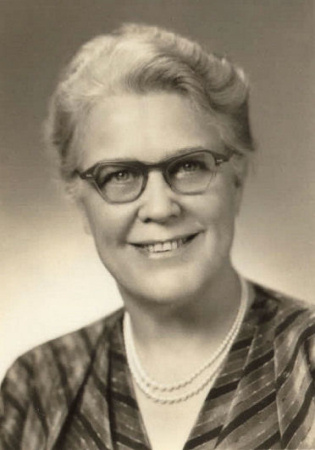
Aunt Lucy in 1956 (Lucy Bridgman Merrill)
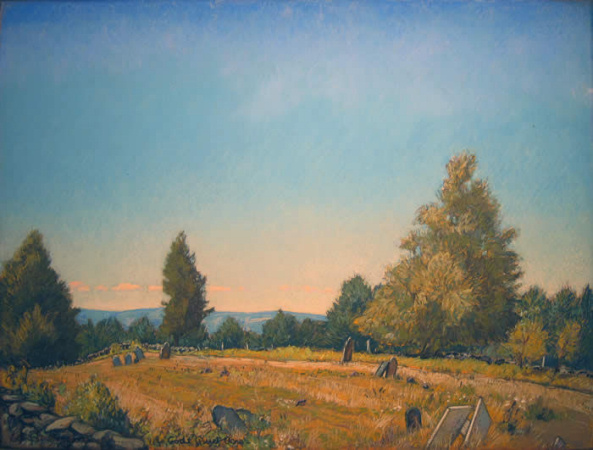
God's Quiet Acre - a chalk drawing by Robert Strong Woodward
Aunt Lucy, Mr. Woodward, and God's Quiet Acre
by
James E. Bridgman
My great-aunt, Lucy Whipple Bridgman, first met the artist, Robert Strong Woodward in June of 1933, after attending a showing of his work at Northfield Seminary. Aunt Lucy had graduated from Northfield in 1914, and she returned to the school frequently for alumnae gatherings and other class meetings. Mr. Woodward's show ran from June 3 through June 12, and one day during that time Aunt Lucy stopped in to Margaret Olivia Hall to see his work. She was immediately entranced by the eighteen oils and thirteen chalk drawings on display.
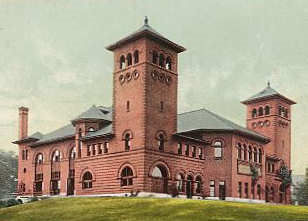
The Auditorium, Northfield Seminary
East Northfield, Mass.
Color printed postcard published by
Detroit Photographic Co. Number 9351.
Copyright 1904. Probably published circa 1907
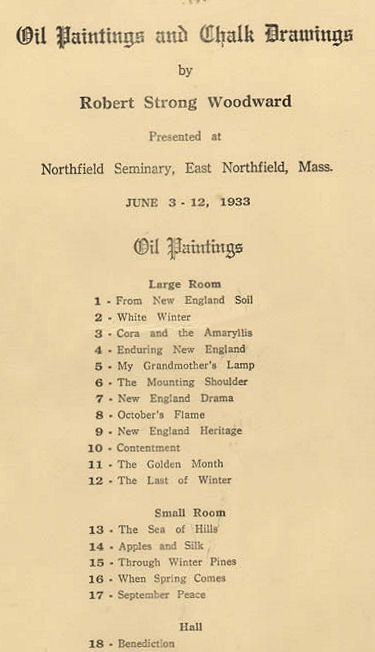
1933 Exhibition Notice
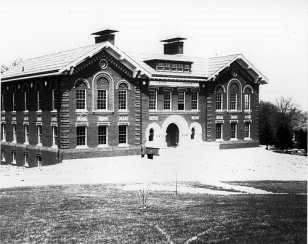
Northfield Seminary, Northfield, MA,
around 1910-20.
Collection #23-2-749, item M-OS-30
Div. Rare & Manuscript Collections,
Cornell University Library
Her first thought, however, was that she would never be able to own "a Woodward," since the oil paintings at that time were selling for $450 and the chalk drawings for $100. Mr. Woodward later told her that before the depression had set in the oils sold for $600 and the chalks for $150, and that one day they would return to those prices. Aunt Lucy was not a wealthy woman, and it was hard for her to imagine spending that kind of money on a work of art.
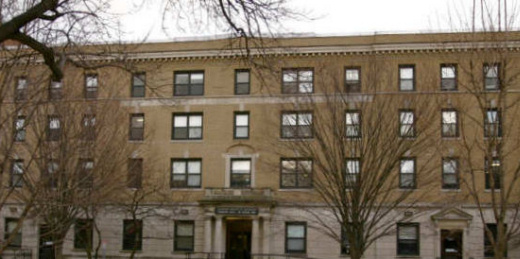
The original Frost Hall of the then Gordon Bible College, now Gordon College.
The college moved here, 30 Evans Way in Boston, in 1917. Bought by
Wentworth Institute of Technology in 1955, it is now Tudbury Hall, a dormitory.
Born in 1893 into a hard-working family of modest means, Aunt Lucy had been raised on a farm in Westhampton, Massachusetts, the youngest of six children. After graduating from Northfield, she taught for a year and a half in the one-room schoolhouse in Loudville - a small factory hamlet a half mile down the road from her parents' farm. (Coincidentally, Robert Strong Woodward would later tell her that he was descended from some Loudville families.) In 1918, she followed her older sister Ruth to Boston to attend Gordon Bible College.
After receiving her degree in 1920, she began work as a secretary for the City Missionary Society, whose offices were located on Beacon Street in the heart of Boston.
Meanwhile her parents turned control of the family farm over to two of their sons and moved to 5 Lambert Avenue in Roxbury to provide a home for their two unwed daughters. Aunt Lucy loved her work in Boston but it was definitely not highly paid.
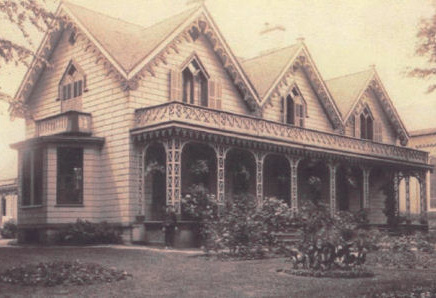
Clifton Spring Sanitarium
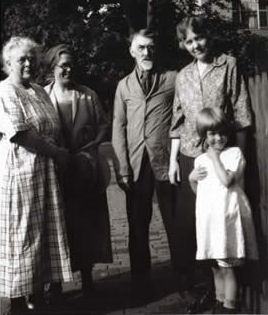
The Bridgman family circa 1925.
Mary S. Bridgman, Lucy W. Bridgman,
Edwin B. Bridgman, Ruth J. Bridgman,
and niece Mary Lillian Boggs
The next two years she was mostly at home in either Westhampton or Roxbury, during which time she did not work. Given her lack of employment in the midst of the Great Depression, it is a strong testament to the power of Mr. Woodward's art that after attending his show, Aunt Lucy was giving serious consideration to spending $100 on one of the chalk drawings. She later said that she felt it was important to feed one's soul, as well as one's body, and she even attributed her recent breakdown in part to "too much economy."
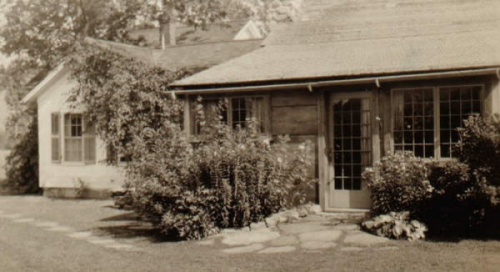
The Hiram Woodward Studio and home
Once again, Aunt Lucy was captivated - not just by the paintings but also by the entire atmosphere that Mr. Woodward had created in his surroundings. Much has been written about this studio, and of the time and effort Mr. Woodward and his hired man Fabian Stone put into restoring the beloved old house and grounds. Aunt Lucy, in writing to Mr. Woodward afterwards, said, "I couldn't help taking away the impression of artistic arrangement in every detail." Mr. Woodward deflected the compliment by writing back, "I was embarrassed to be caught with the studio quite shabby and with faded flowers in the bowl; that is something which rarely happens!"
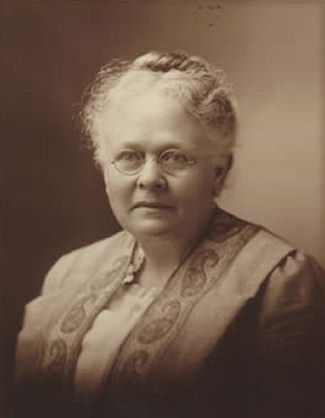
Aunt Lucy's mother, Mary Sophronia Bridgman
in whose memory God's Quiet Acre was purchased
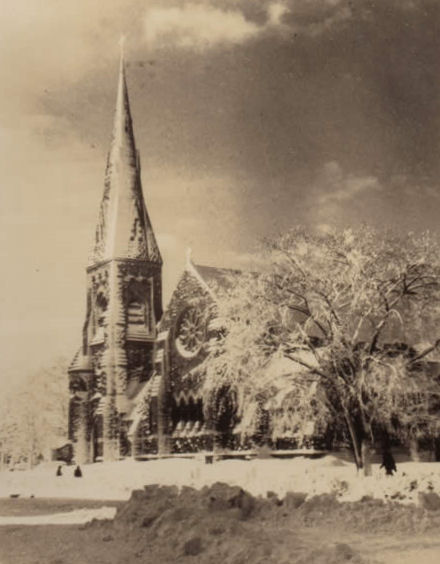
The Harvard Church in Brookline
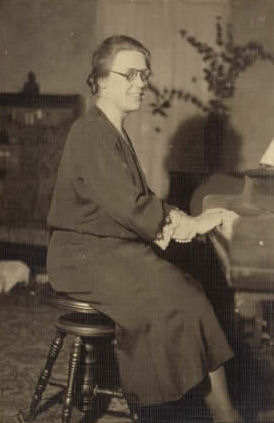
Aunt Lucy in the 1920's
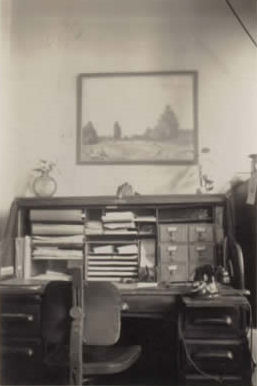
Aunt Lucy's desk at the Congregational
Board of Pastoral Supply, showing
God's Quiet Acre on the wall above
Her intent from the beginning was that the drawing should hang in the office of her sister Ruth, who was secretary at the Harvard Church in Brookline, and it is not clear why she did not want to keep the picture at home. At one point there was some hesitation about whether the Harvard Church location was suitable, as "the light there wasn't right," but eventually an appropriate location in the church offices was found. There is no record of her father's thoughts on her purchase, or if he ever learned the price, but several times Mr. Bridgman told Aunt Lucy and others how much he had enjoyed the visit to Mr. Woodward's studio.
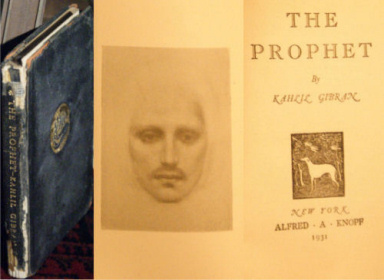
The Prophet by Kahlil Gibran
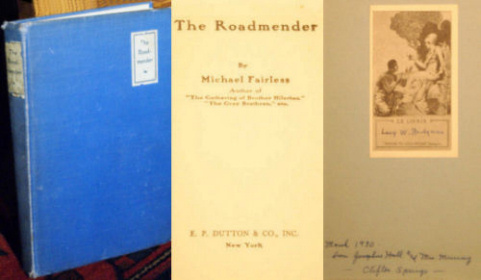
The Roadmender by Michael Fairless
If not, may I loan them to you? To me they are the perfection of art in the literary world - at least they are most satisfying to my soul. I cannot imagine a more perfect setting in which to read them than in your new studio - or out by the brook."
Mr. Woodward wrote back, "No, I have read neither of the books to which you refer - The Roadmender or The Prophet. I thoroughly love to read, but my strength and time these days are so very limited for executing just my painting alone that I get little chance for books and so fall behind the march in things literary and progressive. However, someday I should surely like to delve into the two books you mention."
Aunt Lucy took him at his word and sent to Roxbury to have her sister send the two books out to Westhampton so that she could forward them to Buckland. When Mr. Woodward received the package, he wrote, "About The Prophet by Kahlil Gibran, I have a confession to make. The very second the wrappings fell off your package I realized that I knew the book well, owned it and had read it a number of times!" He said his own copy of the book was larger than Aunt Lucy's and contained "12 very fascinating illustrations by Gibran himself" that, not surprisingly, "meant almost as much to me as the symbolic and imaginative verse itself." He offered to send his copy on to Aunt Lucy so that she could see the images. She readily accepted the offer and wrote, "It is a joy to find so kindred a spirit in the appreciation of The Prophet. I dare expect now that you will enjoy The Roadmender, too."
As it turned out, Mr. Woodward did not send the book to Aunt Lucy, for one day in mid-August he personally delivered it (and another book by Gibran entitled Sand and Foam) to the farm in Westhampton, driven there by his chauffeur, Fabian Stone. The visit was unannounced, and unfortunately Aunt Lucy had gone in to Northampton for the day, so she missed the call that would have meant so much to her. But Mr. Woodward visited from his seat in the car with Aunt Lucy's sisters.
While at the farm, Mr. Woodward couldn't help noticing the giant elm tree that stood at the foot of the driveway. Aunt Lucy had sent him a picture of the tree, a landmark in the local area, knowing that Mr. Woodward found great beauty in majestic trees - and probably secretly hoping that he'd be interested in painting it. Before he left that afternoon, Mr. Woodward wrote Aunt Lucy a short note,
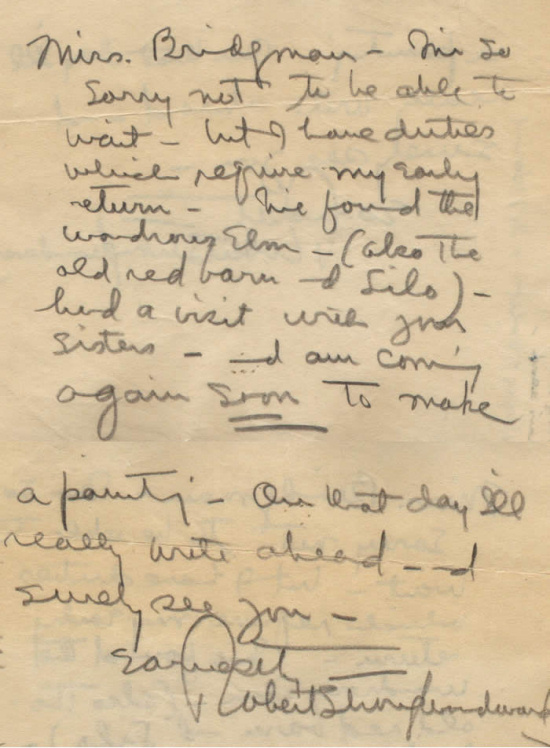
The note left by Robert Strong Woodward and saved by Lucy Bridgman
"Miss Bridgman - I'm so sorry not to be able to wait, but I have duties which
require my early return. I've found the wondrous elm (also the old red barn and
silo), had a visit with your sisters, and am coming again soon to make a
painting. On that day I'll really write ahead and surely see you.
- Earnestly, Robert Strong Woodward."
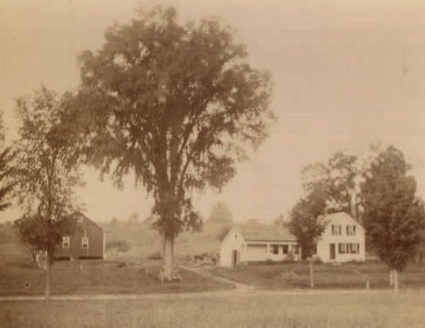
The Bridgman farm in Westhampton around 1897
showing the "Wondrous Elm."
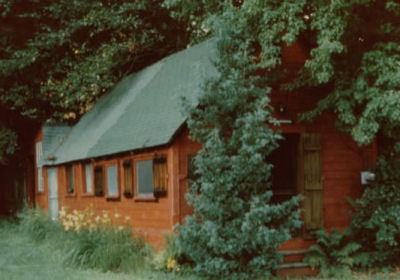
Camp Whip-poor-will
Despite her eagerness to make Mr. Woodward's experience in Westhampton as comfortable as possible, Aunt Lucy was not aware of the extent of his physical needs and of the extreme measures he went through each morning just to get ready for the day. "Unfortunately it is not at all possible for me to stay away from home at night," he wrote, "because I have to transport a nurse, many nurse appliances, a hired man, etc." Mr. Woodward made it clear that it would be far easier for him to make the long drive back and forth between Buckland and Westhampton each day than to try to stay overnight at the farm.
Mr. Woodward promised to let Aunt Lucy know in advance when he would be coming to Westhampton. As August turned to September, she waited for word of his arrival. As September turned to October, and as yet no word came, she began to have doubts. In November, she gave up hope that anything would happen that season, and she headed back to Boston for the winter. Before leaving, she returned Mr. Woodward's books by mail.
In early December, Mr. Woodward finally wrote, "I am so sorry I am not a better correspondent, but I fear I am about the worst one in the world. I am always at least a year behind schedule! It isn't that I wish to be, and am satisfied with the fact, but merely that constantly, week after week, I seem to have more demand on my time than I can ever meet, until months go by and I do not get leisure or free evenings for friendly letters." He went on to say that he had been particularly busy that fall, having made two trips to Boston and four to Holyoke and Springfield, and had sold six paintings and four chalk drawings. "Since early fall, I've not seemed to have one hour for personal communion or leisure!"
Still, Mr. Woodward held out the hope that one day he would paint the noble elm. "I have not at all given up thoughts or hopes of putting your family elm tree on canvass! It happens to be a little far from home to be practical, for a full day's painting, but just the same it is so unusual and inspiring, it is constantly in my thoughts, and I shall plan to surely paint it this coming season. We will surely have some meetings under it next summer!"
Sadly, a stroke of fate intervened early the following summer that effectively put an end to the prospect of Mr. Woodward doing a painting of the Bridgman elm. On July 3, 1934, while he was at a movie theater in Greenfield, Mr. Woodward's beautiful house and studio were struck by lightening and completely destroyed by fire. To lose one's home and workplace in an instant, as it were, was devastating, and it was two years before Mr. Woodward was able to pick up his brushes once more. All thoughts of working in Westhampton were laid aside, apparently never to be entertained again. Eventually the famous elm tree fell victim to the dreaded Dutch elm disease and was removed.
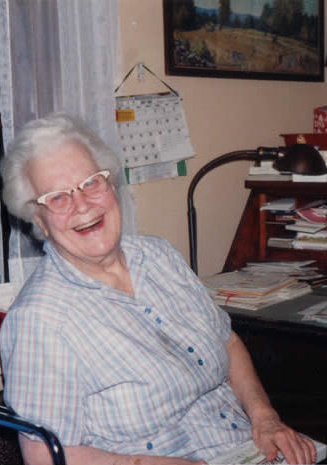
Aunt Lucy in her 90's with just a bit of
"God's Quiet Acre" showing above her desk
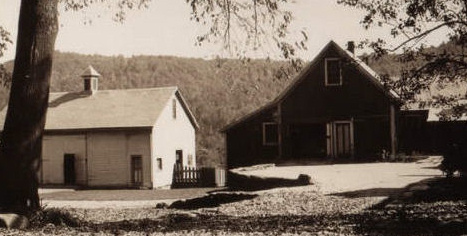
The Southwick Studio on Upper Street, Buckland, Massachusetts
In every letter they exchanged, mention was made of God's Quiet Acre. In one he wrote, "To me it will always outstand as one of my most beloved creations. It is surprising how many of my old patrons and friends still ask for it when they call at my studio to see me and my work. Let me hear from it once in a while." And she once wrote, "It has taken me several years to notice one detail in God's Quiet Acre! I got a big 'kick' last week when I realized that you had very particularly placed your signature outside the stone wall!" In 1947, they exchanged letters about a problem Aunt Lucy had run into when the walls of her office were painted "Nile green," thus clashing with the "big expanse of blue sky" in the drawing. Mr. Woodward kindly wrote back with various suggestions to mitigate the situation.
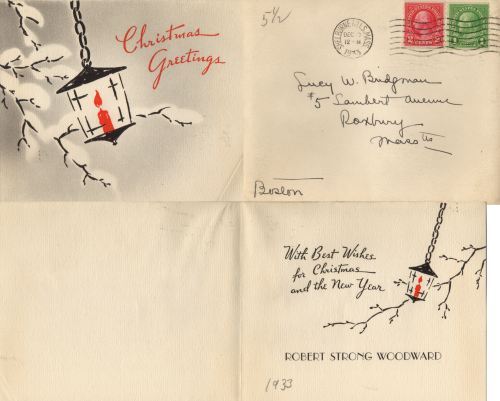
RSW's 1933 Christmas Card to Lucy Bridgman
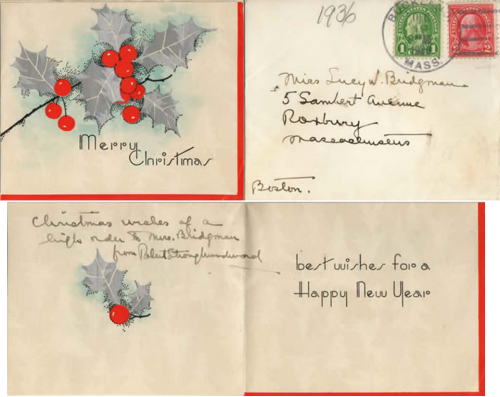
Christmas Card to Lucy Bridgman from RSW in 1936
"Christmas wishes of a high order to Miss. Bridgman
from Robert Strong Woodward"
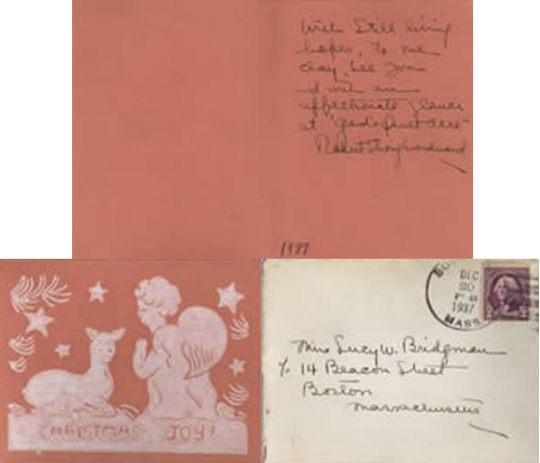
Letter from RSW to Lucy Bridgman. "With still living hopes to one day see you
and with an affectionate glance at 'God's Quiet Acre' Robert Strong Woodward"
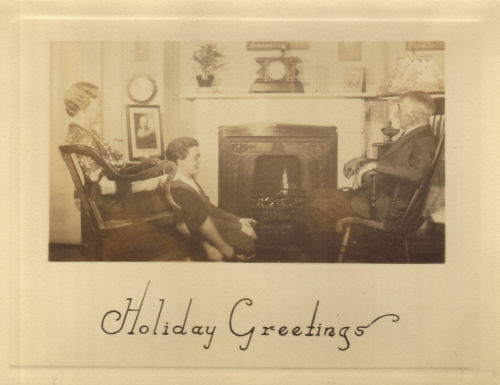
The Bridgman's 1938 Christmas Card with Ruth, Lucy, and their father
in front of the fireplace at 5 Lambert Avenue in Roxbury, Massachusetts
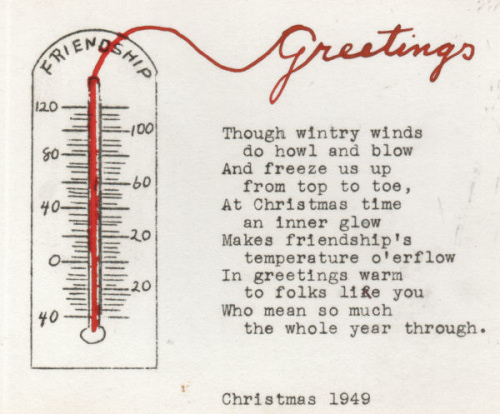
Aunt Lucy's 1949 Christmas Card, which Robert Strong Woodward
mentioned in his last letter to her
In January of 1950, Mr. Woodward wrote what was to be his last note to Aunt Lucy. "Dear Miss Bridgman - All the phases of your Christmas card to me were keenly appreciated and I thank you. During the holidays I was ill so kept from mailing greeting cards to friends, as I love to do, but I did not forget you. May the New Year hold the best for you! - Robert Strong Woodward."
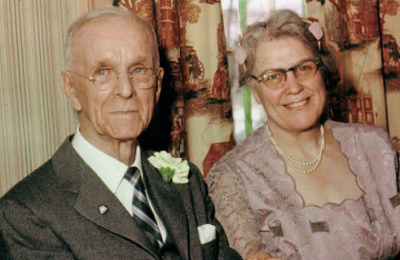
Rev. Charles Clarkson Merrill and his wife, Lucy
They set up housekeeping at 74 Kirkland Street in Cambridge and God's Quiet Acre found a prize location in their apartment. After Rev. Merrill's death in 1961, Aunt Lucy settled in Northampton, where she lived for many years at 118 North Elm Street, across from Child's Park, and then, for her last eight years at the Lathrop Home on South Street. When she died in 1989, at age 95, her beloved God's Quiet Acre was hanging on the wall across from her bed.

Lucy's own "Quiet Acre"
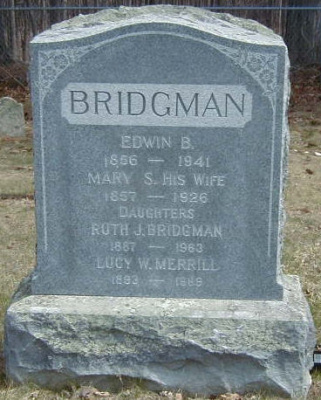
Lucy's grave stone
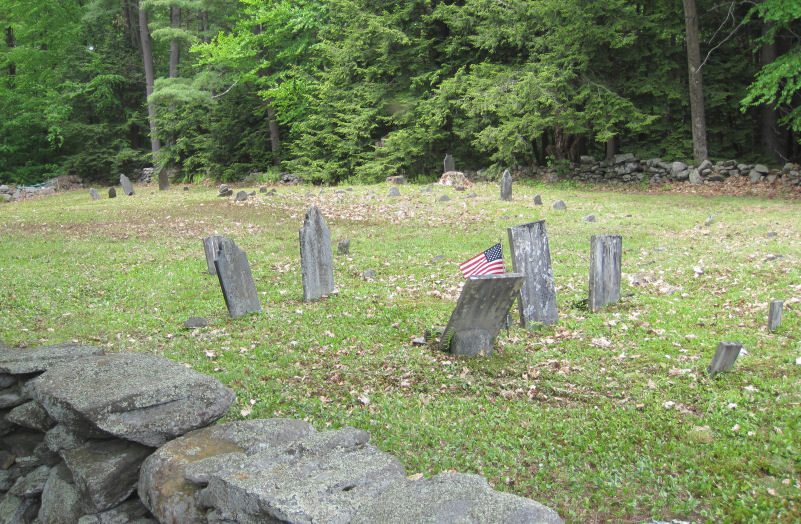
The Cemetery in "God's Quiet Acre" as it appears today

James E. Bridgman, 2010
by
James E. Bridgman
2010

